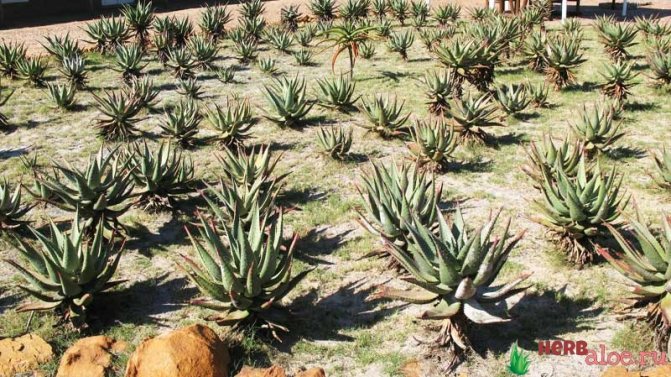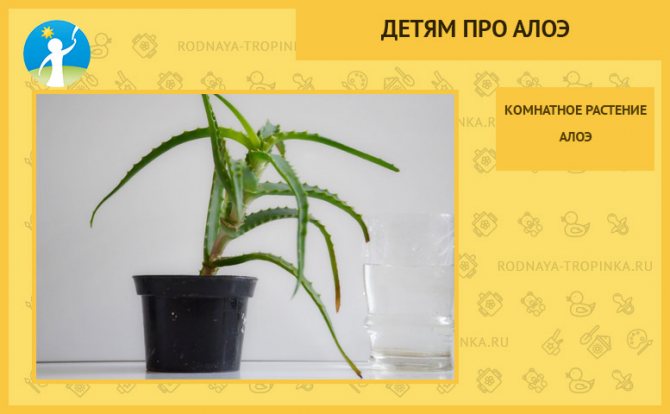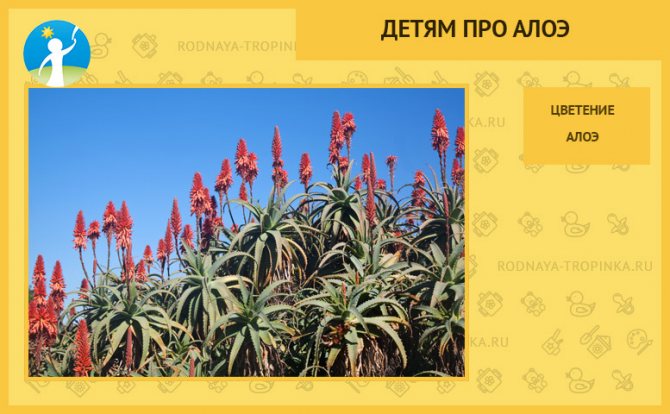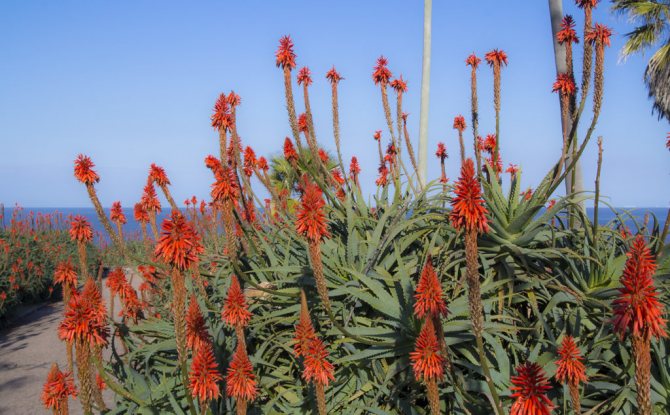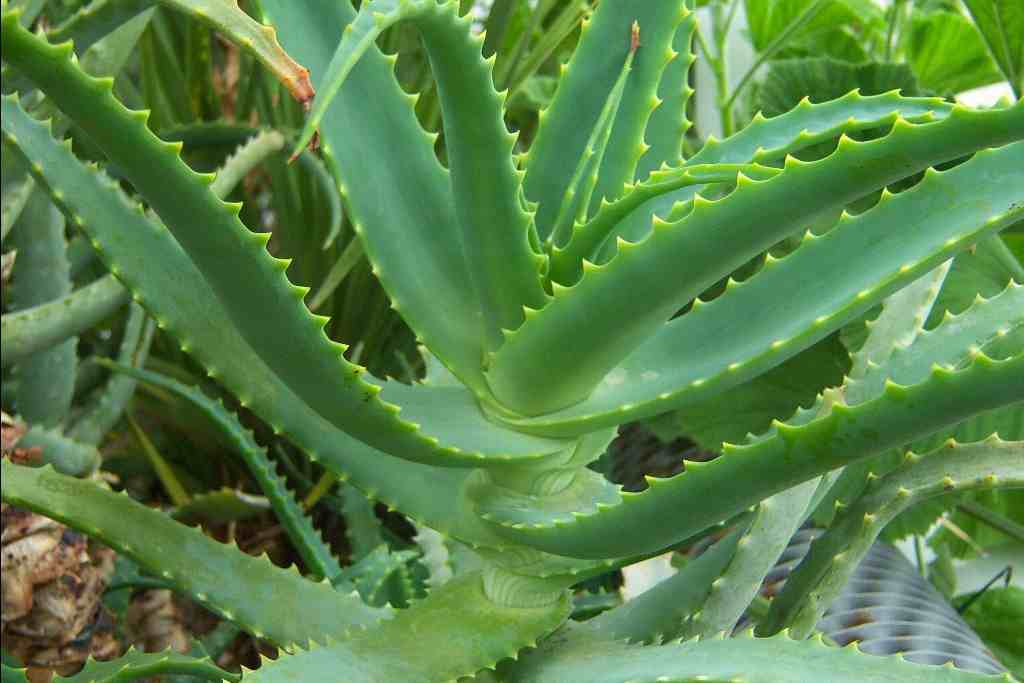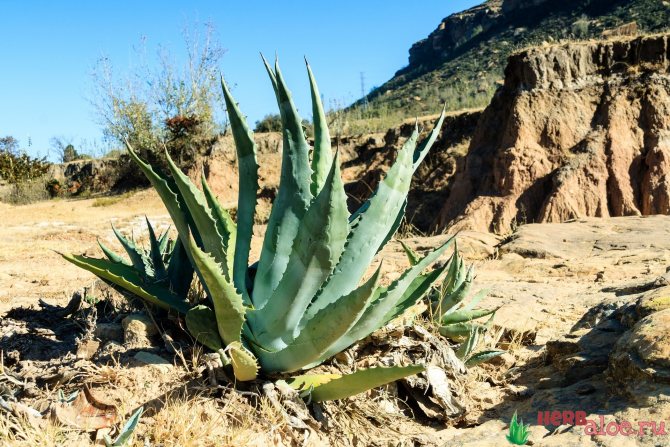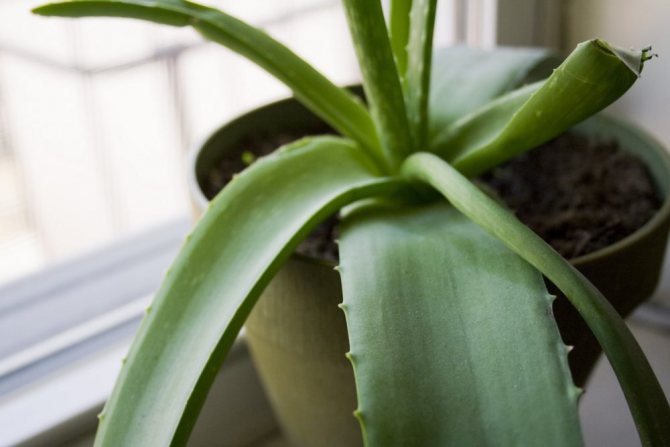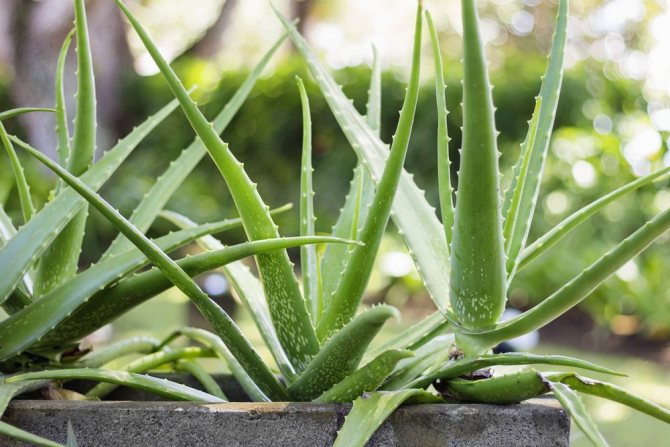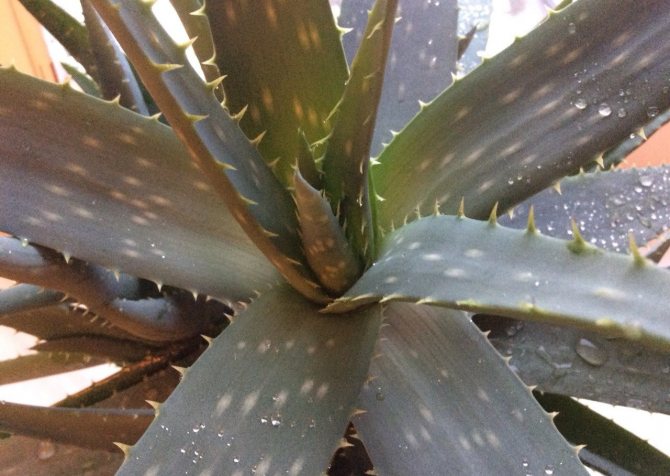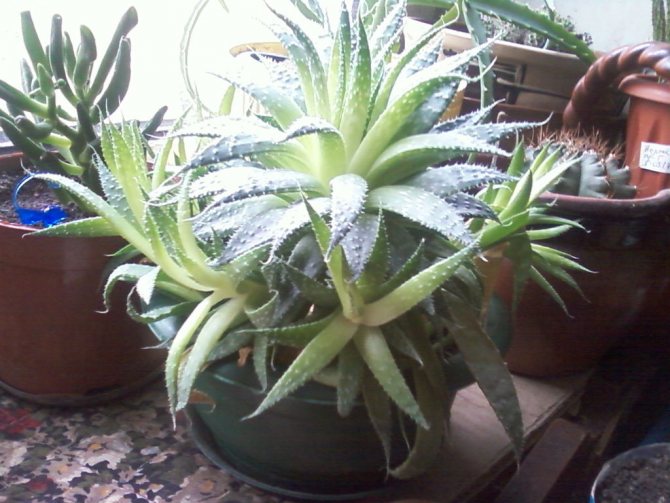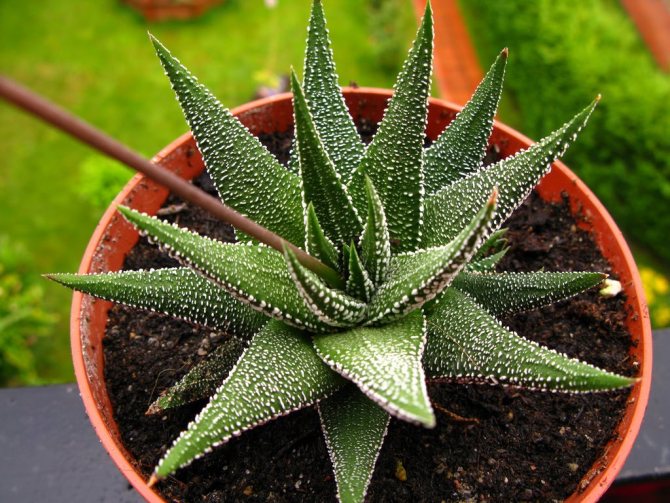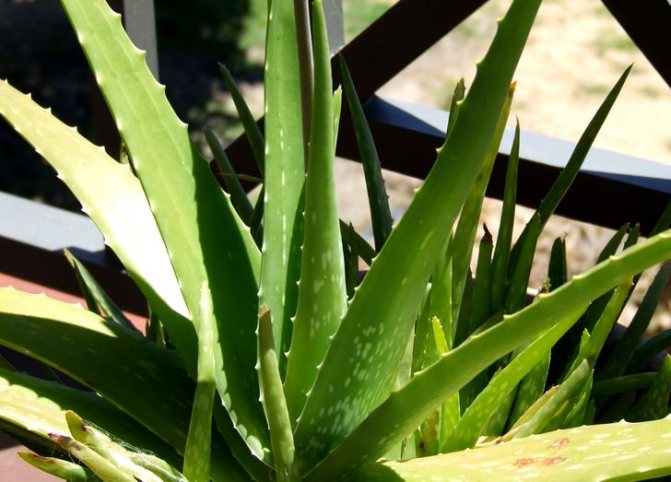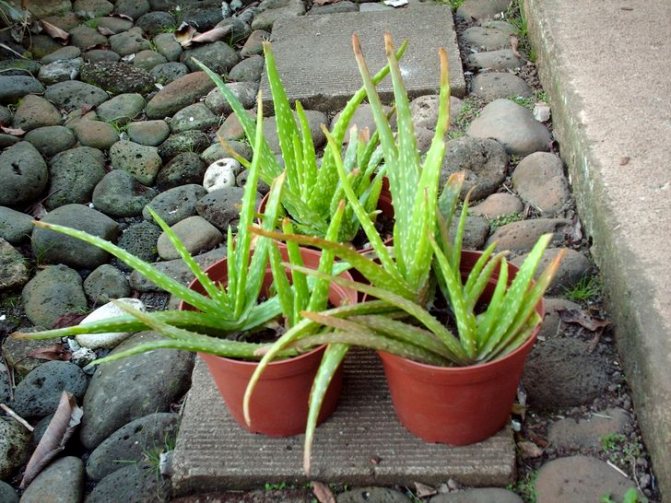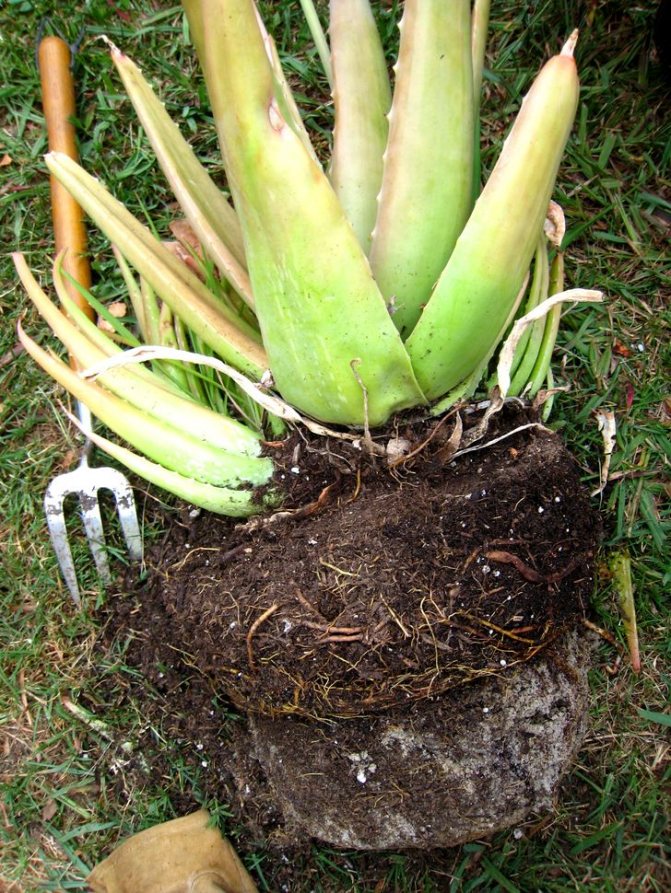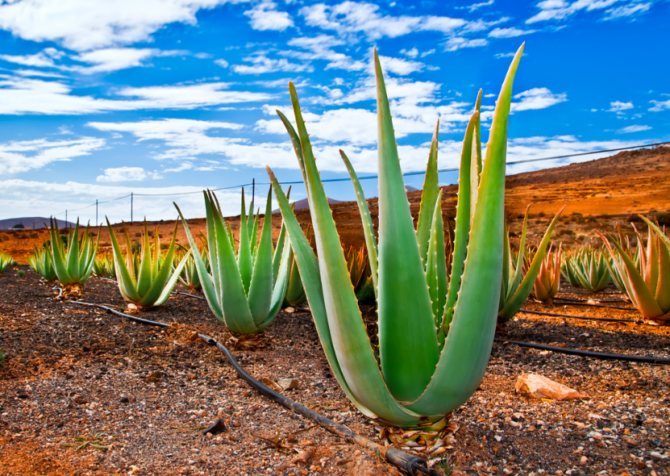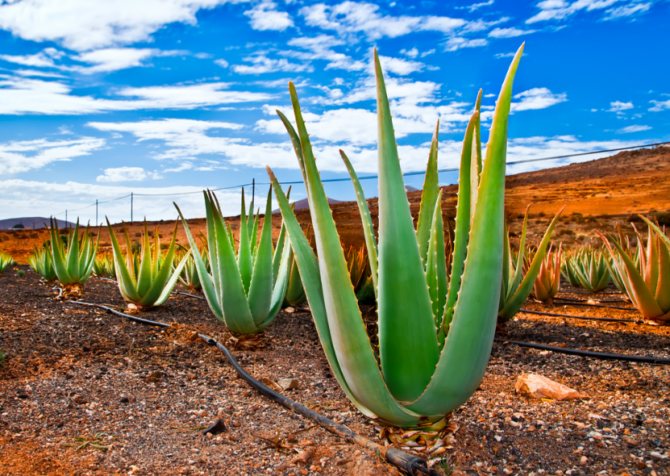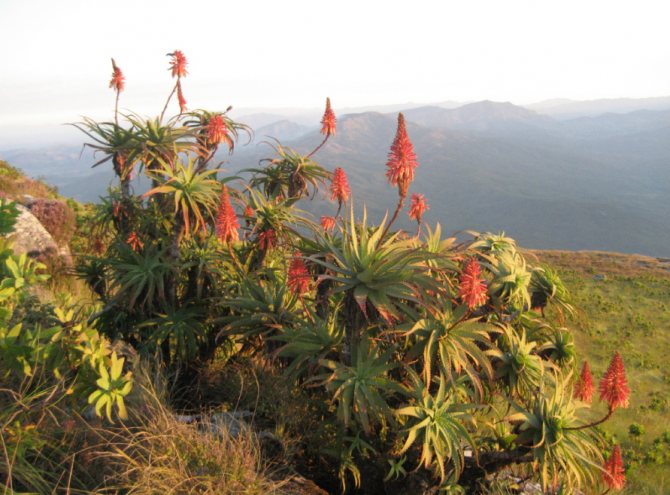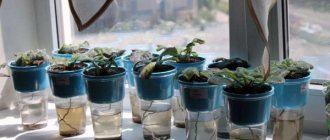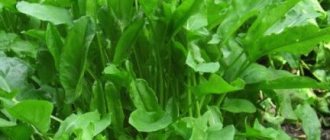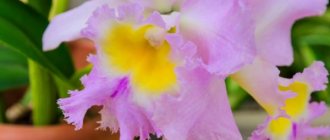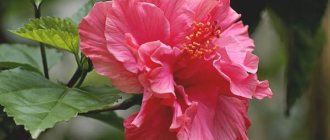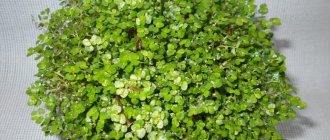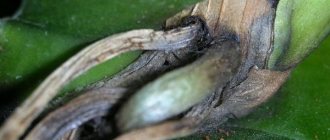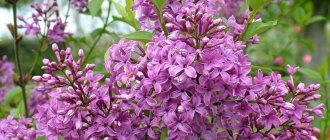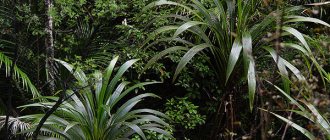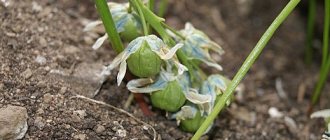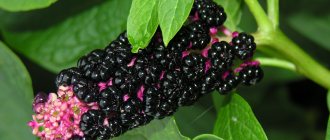Author Alexander Ashurov
Updated: 23.10.2019 14:19 Published: 28.09.2018 17:00
Gardening »Indoor flowers
The ancient Greeks knew about the existence of aloe and what miraculous properties this plant possesses. According to one of the legends, Alexander the Great even conquered the island of Socotra due to the fact that aloe grew there. Various medicines were made from the juice of this plant, because even in ancient times they knew that aloe helps to relieve inflammation and treat skin diseases. Here are some interesting facts about aloe.
26 shares
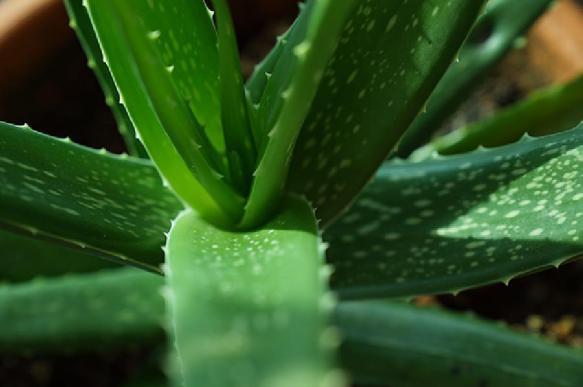
Houseplant varieties
Many lovers of indoor flowers have long been growing aloe on their windowsill. The varieties intended for the home are unpretentious and do not require special knowledge.
This succulent variety can grow up to 2-4 meters in height. It has large green lanceolate leaves covered with thorns. Leaves develop up to 20-40 centimeters in length. The homeland of the aloe tree flower is the southern regions of Africa. The variety is most often used for home breeding due to its ease of care and.
Tree aloe
Also called "present". Vera is closest in composition to the tree-like aloe. The description of the plant is slightly different. It has larger fleshy evergreen leaves, the trunk, in contrast to the tree-like one, is absent. Houses can be used for decorative purposes as well as used.
Aloe vera
Spinous
The plant belongs to perennials, homeland is the countries of Africa. Scarlet spinous has large leaves, collected at the base in a rosette, the diameter of which reaches 50-60 centimeters. The leaves themselves are hard, rough, have white stripes. Outwardly, it is completely different from the usual scarlet, there are no useful properties. It is not used for treatment or cosmetology. However, for decorative purposes, spinous aloe is predominantly chosen. Home care does not require much effort. The flower of this variety is remarkable. It is similar to the flowering of the closest relative, the eremus.
Aloe spinous
Variegated (brindle)
The succulent got its name for its characteristic white stripes, similar to the color of a tiger. Aloe variegated, native to Namibia and Zimbabwe, is widely used to decorate homes and offices. Tiger aloe has large leaves collected at the base. However, it does not have a round rosette like spinous aloe. Succulent care is also elementary. With proper watering and lighting, it blooms 1-2 times a year. It is not used for treatment.
The exact composition of a plant depends on its variety, homeland and growing conditions. The data in the tables is correct for Vera and the tree succulent.
Table 3. Main components
Useful video
Aloe is a well-known succulent plant that is found in almost every home. Many people use it not only for interior decoration, but also as a "home doctor":
Aloe
(lat. Áloë) is a genus of succulent plants of the Asphodelic family (
Asphodelaceae
) of the subfamily Asphodelic (
Asphodelo> [3], common in Africa and the Arabian Peninsula. Previously, the genus Aloe belonged to the Aloe (Aloaceae
) and Xanthorrhea (
Xanthorrhoeaceae
)
Features of home care
It is recommended to grow succulents in the soil for cacti.It is better to put the pot on the south window, because the homeland of the plant is hot countries. Rare watering involves any kind of succulent. Features of growing at home.
It is best to water once every seven days, and in winter - once every 15 days. The exception is variegated aloe. Home care involves watering every 5-6 days.
The plant should be transplanted every 2-3 years. In order not to damage the root system, it is recommended to use the transshipment method. It involves maintaining a small clod of old earth around the root. Do not water the plant for 4-5 days before transplanting.
There are many ways to breed. Aloe, whose country of origin has a hot climate, usually propagates by seeds in natural conditions. However, growing a plant in this way at home is not easy. It is optimal to propagate succulent with the help of "children". The plant forms miniature shoots with roots. It is enough to plant the shoot in a pot, and it will surely take root. In addition, it is possible to resort to cuttings or root the leaves.
Basic description
The stem of aloe is short, fleshy, xiphoid leaves are located on it, they are collected in dense rosettes. The edge of the leaf can be smooth or spiked. Inside the sheet, there are many chambers in which moisture is stored. Blooms, releasing a long peduncle, on which a brush with buds is formed
tube-shaped (red, orange, white). It is not easy to achieve flowering indoors.
Types of beautiful climbing plants for the garden
Hot countries are considered the birthplace of the indoor plant aloe.... For normal growth and development, he needs:
The homeland of the origin of aloe is areas with difficult climatic conditions. The flower has adapted well to life in arid zones. Propagated by leaf, cuttings, children (root shoots), top and seeds (they can only be obtained from a faded plant). Any parts of the plant quickly take root and take root. Before planting, it is necessary to put them in the refrigerator for a week, wrapping paper so that the cut dries up and the juice ceases to stand out.
The leaves are best separated from the bottom of the plant. They are larger, stronger, and take root faster than small ones. A healthy lateral shoot is taken as a cutting.
Babies are called young growth.
that extends from the root. Young shoots must be separated and planted in different containers. The fastest way to get a new plant is to cut the top off, which should have at least seven leaves.
The most difficult way is seed. It is rarely used at home, as it is difficult to achieve flowering and obtain seeds. Young plants do not need special care.
Are aloe and yarrow the same thing?
This flower has several other names, in our country it is called agave
, since it was believed that aloe blooms once every hundred years. But today it is known that this is not so, at home, an adult plant blooms from November to March, but not every year, while the fruit with seeds does not ripen.
Sometimes aloe is confused with yarrow, but these are two different types of plants and they look different from each other. Yarrow got its name precisely because of the abundance of small white flowers on its stem. It blooms throughout the summer, so it's very easy to recognize it. It is very unpretentious to its habitat; it is found everywhere in central Russia. The real aloe grows only in warm areas where there is no snow.
But in some ways these two plants are similar, they both taste very bitter and have the following useful properties:
- stop blood and strengthen blood vessels;
- have anti-inflammatory and bactericidal effect;
- accelerate the metabolism in the body.
Aloe can be found in many homes.And everyone knows very well that this "miracle doctor" is not only beautiful, but also very useful. On the pages of our site, we will tell you about many diseases and how to lose weight. And also you can learn about Aloe vera - one of the most popular species of this wonderful plant.
What you need to know about aloe?
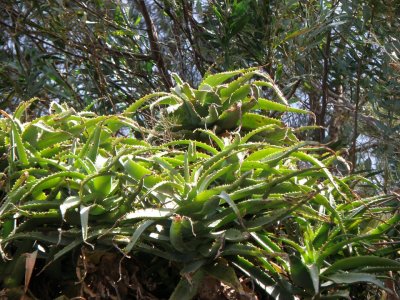

History
The first mentions of this medicinal plant can be found in more than 2 thousand years BC eh
... The ancient Egyptians studied it and used its useful properties. The image of aloe is even found in drawings in the tombs of the pharaohs. Thanks to the methods of using the flower in medicine, it was called
"Plant that bestows immortality"
... This status may also be associated with the fact that it was used in the embalming of the dead.
Where the name of the flower came from has not been established for certain, there are several theories. According to one of them, it was formed from the Greek words "salt" and "give", which meant - a plant with the juice of the taste of sea water. When adapting to the Latin language, one word came out - "bitter", which sounds like aloe. According to other versions, there are consonant words for bitter taste in Arabic and Hebrew.
Homeland of the aloe plant
The homeland of aloe is the islands of Barbados, Curacao and the west of the Arabian Peninsula. Aloe owes its spread to other continents to people, since the fame of its beneficial properties gradually reached all corners of the planet. Almost all countries in the world aloe has become a popular home plant.
Where is aloe found?
Now wild aloe is widespread in African countries: South Africa, Swaziland, Mozambique, Malawi, Zimbabwe, Somalia, Ethiopia and Egypt. It is found in southern Asia and in countries with warm climates such as Turkey and Greece.
Growing conditions in nature
In nature, aloe is impressive in size and reaches 4 meters, the leaves grow up to a meter in length and 20-30 cm in width. It is known in total more than 350
of this plant, most have a tree-like trunk, the rest look like a spreading bush. On its leaves, thorns or hairs are found at regular intervals.
These flowers prefer to grow near semi-desert coastal areas, surrounded by other shrubs. They are often found in savannas with gravelly or sandy soil. The area of growth even reaches mountain deserts with a height of up to 2750 meters above sea level.
What kind of soil does the agave prefer?
Aloe accustomed to the most extreme conditions
and during drought, it closes the pores on the peel, thereby retaining water inside the leaves. Therefore, where other plants die, this flower feels comfortable, it is prepared for poor watering and poor soil. Ideally, the soil for this plant consists of the following types of fillers:
- gravel;
- shell rock;
- river sand;
- brick chips;
- volcanic rock - perlite;
- loose soil with a neutral water-alkaline balance, including clay, sand, humus and sod.
In an imaginary section of the pot, the soil should look like this: drainage at the bottom, then earth, and at the top, coarse sand mixed with gravel.
Fertilizers for aloe are practically not required, many of them can harm the flower.
Useful video
In the following video, you will see different types of wild aloe:
If you find an error, please select a piece of text and press Ctrl + Enter.
Aloe is considered to be one of the most valuable plants. The homeland of the plant is hot countries. It has become widespread in the world due to its healing properties. The fame of aloe spread rapidly, and merchants from different countries gladly took the seedlings back to their native lands. They have been used and are used for the production of medicines, cosmetics, food, etc.
What does aloe look like?
Roots
In wild aloe, the root system is one long, straight root with strong branching.Domestic flowers are much more compact and even the most shallow pots
in order to grow calmly.
Stem
On its straight stem, the leaves branch in the form of a fan; they have a greenish-gray color. By its type, the leaves are smooth, fleshy and juicy, lanceolate-linear in shape and have sharp teeth at the edges.
Aloe thorns are poisonous and after a prick, redness and tingling appear on the skin.
Leaves
The bluish shade of color gives the leaves a special waxy coating, it is not erased from water and is designed to moisture from the leaf evaporated less.
The sheet itself is divided into cells inside, it is in them that water accumulates.
In winter, it is not recommended to water home aloe; without sunlight, its leaves will try to grow, but they will turn out to be thin and ugly. In hot weather, in addition to watering, spraying should be done, which in the wild is replaced by morning dew.
Flowers
When the aloe decides to bloom, then its owner is lucky to see large flowers up to 4 cm in length. They are dull orange in color, tubular and bell-shaped in structure. The inflorescence itself is racemose and in large specimens reaches 40 cm in length. Aloe flowers are fragrant and exude a lot of nectar.
Fruit
At home, the fruits of aloe flowers do not ripen, but in nature they look like triangular boxes. They have a lot of dark gray seeds with wings, thanks to which they expand their range of growth.
Aloe is a popular crop among domestic plants, not only because it has a number of beneficial properties, but also because it does not require much. After all, if you forget to water it, he will not even notice. It is useful to know about what grows in your home in pots, because before that, the plant has come a long way of spreading along the earth and has benefited many people, and now it pleases you too.
Description of aloe. The genus contains over 300 species of succulents, as well as hybrids, small and large, rosette plants. These are evergreen perennials, shrubs or small trees.
Aloe or agave is a slow growing succulents found mainly in the African bush (shrub thickets) and varying in size and shape. Many of them have fleshy, thick leaves that have hooked teeth or spines, even in the middle of the leaf. The thorns vary in size and shape depending on the variety of aloe. The color of the leaves ranges from green to blue-green, with some aloes even reddish in color. Variegated forms have blotches, spots or stripes on the leaves. Leaves reach 30 - 60 cm in length and 5 - 8 cm in width.
Aloe emit a tall, slender peduncle up to 90 cm high from the center of the outlet, it can be branched. Flowers vary in size but are generally tubular, ranging from white to bright red, yellow and orange. The seeds form in dry capsules as soon as the flowers disappear. Homemade aloe blooms only 3-4 years after planting, but its flowers have a pleasant sweetish aroma. For flowering, you need to keep the aloe outdoors in a warm period and provide the plant with sufficient sunlight indoors.
Indoor aloe is a long-lived houseplant, which justifies its popular name - agave, and its juice has an amazing healing effect when rubbed into wounds, bruises and even hair. It can also be used to relieve burn pain. Aloe has been cultivated for a long time and acclimatized in many countries of the world, where it is used both in medicine and in cosmetics.
Title [edit | edit code]
The generic name for aloe goes back to the Greek. ἀλόη, which is derived from Arabic (ألوة / alwa) or Hebrew (אהל / ahal, often mentioned in the text of the Bible [4] [5]). From Greek the word is borrowed into Latin in the form aloë.
A more accurate spelling of the scientific name - Aloë
where is the letter
ë
- not Russian "ё", but Latin
e
with a dieresis sign, meaning that in this case the combination oe is pronounced as two separate sounds ("oe").
The word “agave” is used as a common Russian name for some species of the genus Aloe [6].
Varieties of aloe:
Aloe tree - Aloe arborescens
The most common species in indoor culture, with long, very succulent, green or bluish-coated leaves. Almost 99% of aloe leaves are water. On the edge of the leaves, there are short but strong thorns. In its natural environment, this species blooms with large pink flowers, but at home, flowering rarely occurs.
Aloe white
Pure white varieties of aloe do not yet exist, but there are several subspecies, the leaves of which have light shades, as close as possible to white, for example, Somali aloe - Aloe somaliensis, short-leaved aloe - Aloe brevifolia, Descuana aloe - Aloe descoingsii and Aloe dhufarensis.
Aloe variegated, striped or brindle - Aloe variegata (Tiger Aloe)
A small succulent evergreen plant forming a rosette or large, succulent, triangular, sessile leaves. The leaves are colored in a dark green shade with transverse light stripes and a light border along the edge of the leaf plates. During the flowering period, it throws out tall erect peduncles, on top of which there are many pinkish-red tubular flowers with small petals.
Aloe fierce - Aloe ferox
In its natural environment, it reaches 2 - 3 m. In height. Based on the name, it becomes clear that this subspecies is equipped with strong thorns, and they grow not only on the ribs, but also in the center of the leaves. The leaves are oblong-triangular, green, with a bluish waxy bloom; in bright light they acquire a pinkish-purple hue. Peduncles bear inflorescences on the tops - candles, which contain a very large number of orange flowers with a long flower tube.
Aloe Barbados or Aloe Vera - Aloe vera
We are all familiar agave
... It is a succulent evergreen shrub up to 1 m high. The stem bears long, succulent, light green leaves with thorns on the ribs, arranged spirally. Young leaves sometimes have lighter or darker spots on their surface, but they disappear with age. When kept in direct sunlight, the edges of the leaves become pinkish. It is widely used in medicine and cosmetology.
Aloe multifoliate
living in the mountains of Lesotho at an altitude of about 2500 m above sea level, tolerates frost and snow for a long time. Have
aloe bulbiferous
in the lower part of the inflorescence, instead of flowers, "bulbs" develop, which also serve for vegetative reproduction.
There are very attractive forms of variegated aloe with light spots or red-purple leaves, some varieties are distinguished by the presence of a large number of long white or even pink spines.
Height
... Up to 1 m.
Biological characteristics of the agave: appearance, flowering
Evergreen succulent plant, up to 4 m high... The root system is fibrous. The branched roots have a cylindrical shape and are grayish in color. The stem is erect, branching.
Plants are decorated with successive leaves, which are juicy, fleshy and have cartilaginous thorns along the edges, curved at the top. At the top, the surface of the sheet plate is flat, and at the bottom it is convex.
The flowers are orange, bell-shaped, tubular, collected in an original raceme at the end of a long peduncle. The fruit is presented in the form of a box, resembling a cylinder.
Flowering occurs in the winter season, but is not constant, while the flowering plant does not form seeds.
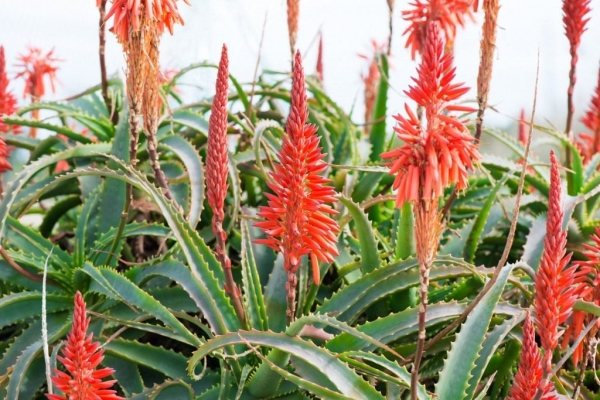

Blooming aloe
Aloe at home
Temperature conditions
... Indoor aloe - plants that are hardy to any temperature of living quarters.The optimum temperature is 21 - 26 ° C, it tolerates a drop to 10 ° C. Aloe does not like intense heat, wintering should take place in a cool visit with a temperature of about 12 ° C. For the onset of flowering, a cool wintering is very important.
Growing aloe - lighting
... Prefers very bright light, but not direct sunlight. In autumn and winter, in the absence of a dormant period, the plant may need additional lighting with fluorescent lamps. Do not move the plants out of the room into direct sunlight - allow the leaves to gradually adapt to changing lighting conditions.
How to care for aloe
... Aloe is undemanding to care for, suitable for novice growers. It is important to provide them with good drainage and sufficient sun. Remove peduncles and old leaves in a timely manner after flowering. Tall varieties often require support for good growth. Bring plants to fresh air during the warmer months using a shelter from the rain. Some tall species need pinching to form a compact, beautiful plant. Pruning of long stems is carried out in the spring, with the beginning of new growth, and old, drying leaves are also promptly removed.
Growing conditions - soil
... Any suitable soil for cacti and succulents with a slightly acidic pH and the addition of large amounts of coarse river sand to improve drainage.
Top dressing
... In the spring and summer, during the growth period, fertilize once every two weeks in a half concentration. In autumn and winter, when the plant is resting, no feeding is carried out. Remember that aloe is a succulent and stores a large supply of moisture and nutrients in thick leaves.
Appointment
... Aloe flower in a pot is a decorative leafy showy plant, and aloe juice has many useful properties and is widely used in cosmetology and folk medicine. The sap of the plant has many beneficial and medicinal properties. Aloe with honey and lemon strengthens the immune system and is used as an expectorant.
Flowering time
... Blooming aloe in culture is a rather rare phenomenon, flowering occurs only with a good source of light.
Air humidity
... A very undemanding plant, fairly dry air will do. If the aloe plant is kept cool during the fall and winter months, the air around it should be dry. Aloe does not need spraying, and the ingress of water droplets into the leaf outlet can provoke the appearance of rot.
How to water aloe at home.
The plant is a succulent, its leaves contain up to 96 percent water, it tolerates drought well. Be sure to dry the substrate between waterings. In winter, water very rarely and every time make sure that drops of moisture do not fall into the outlet of the leaves - the plant will rot. Low varieties can be watered by immersing the pot completely in a large container of room temperature water. Of course, the excess moisture from the pallet should be drained immediately after watering. In spring and summer, when the plant is actively developing, it is worth watering so that between waterings the soil dries to a depth of about 2 - 3 cm.
How to transplant aloe
... As the pot fills, indoor aloe plants are planted in a container of slightly larger diameter. for planting, pick up a slightly cramped pot with large drainage holes, the diameter of which should be half the length of the leaves. After transplanting into fresh soil, stop watering for 7 - 10 days. Old and rotten roots are cut off with a sharp sterile instrument during transplantation.
How to propagate aloe
... Petioled leafy cuttings can be rooted fairly easily in spring or summer at temperatures around 20 ° C, but be sure to dry them for a few days before planting. Watering is very economical, rooting takes a long time - about a month. Apical cuttings and small daughter plants, which sometimes appear near the mother plant, are also used for reproduction. Rooting can be done in a regular glass of boiled water.Seeds, warm - 21 ° C.
Aloe pests and diseases
... Most often, keeping aloe in room conditions does not cause any particular difficulties. Plants can be attacked by mealybugs. Inspect the leaves regularly for these pests, and if the plant looks weak, remove the top 1 to 3 cm of the substrate and make sure the roots are not affected.
Sunburn can cause dry brown spots on the leaves, especially if the plant is exposed to the sun immediately after watering. Over-watering is the cause of leaf wilting, especially in cool conditions. A reddish tint appears on the leaves under excessive light, the leaves turn pale when grown in the shade. Pale leaves indicate a lack of light - move the plant to a brighter area.
Tall species lose their lower leaves with age and become less attractive. In such plants, the top is cut off and, after preliminary drying, is rooted in wet sand. The cut can be sprinkled with crushed coal. Also, large specimens during transplantation can simply be buried in the ground so that the trunk, bare at the base, is not visible.
Note
... Aloe juice, and especially aloe vera, is used in cosmetic lotions, creams, ointments, and shampoos. It is believed that it was used by Cleopatra. The juice has tonic, bactericidal, wound healing and anti-inflammatory properties. For diseases of the respiratory system, aloe juice is taken orally mixed with honey, in addition, the juice of the plant is able to strengthen the immune system and increase the number of red blood cells in the blood - it is used for anemia. The plant is poisonous to cats and dogs. An amazing feature of this plant is that its juice is used for rooting cuttings and for soaking the seeds of other plants - this is the percentage of rooting and germination of seeds. The plant has phytoncidal properties and is capable of killing pathogens in the air, and in addition, it very effectively cleans the atmosphere of harmful gases such as formaldehyde.
Taxonomy [edit | edit code]
The APG II (2003) classification system assigned the genus aloe to the Asphodeloid family. The APG III classification system that replaced it (2009) included asphodelics in the Xanthorrhea family ( Xanthorrhoeaceae
) as a subfamily, the APG IV (2016) classification system returned the genus to the Asphodelic family.
Read also: What is green soap used for
In traditional taxonomy, the genus was singled out into its own family Aloaceae (Aloe, or Aloe), and sometimes it was assigned to the Liliaceae family. Close relatives of aloe are the genera Gasteria, Haworthia and Kniphofia, which have the same growth method, often in everyday life these genera are also called aloe. Sometimes "American aloe" is called American agave ( Agave americana
), although it belongs to a completely different family - Agave.
Summing up - 7 secrets of success:
- Growing temperature
: summer - 20 - 27 ° С, winter - it is advisable to provide a cool dormant period at a temperature of about 10 ° С. - Lighting
: the plant is very light-requiring. - Watering and humidity
: Dry the substrate a few centimeters deep between waterings between waterings, in winter, reduce the frequency of watering in accordance with the room temperature. - Features of the
: aloe has many useful properties and is used in folk medicine and cosmetology, it is easily grown by novice growers. Tall plants need support. - Priming
: well drained with slightly acidic pH. - Top dressing
: a highly diluted solution of fertilizers for succulent plants 2 times a month in the warm season. - Reproduction
: leafy or apical cuttings, less often seeds.
You may also be interested in:
Photo
For more photos of aloe, see below:
Application
Fresh juice - for gastritis (chronic) with low acidity, and a tendency to constipation, in order to improve the body's resistance to infections, to increase appetite. Outwardly, it is used for burns, wounds, including purulent, abscesses, trophic ulcers, phlegmon, osteomyelitis and other purulent diseases. For diseases of the gums, oral cavity, pharynx, rinsing is used. Compresses are also made with aloe juice, using them for lupus, eczema, skin tuberculosis, and radiation dermatitis of the head.
Aloe syrup with iron is made for acute and chronic diseases of the gastrointestinal tract, which are associated with post-hemorrhagic anemias, after infectious diseases, as well as with hypochromic anemia of various etiologies and other intoxications and diseases that deplete the body. In gynecology, aloe is used for cervical erosion.
Liquid extract for iritis, keratitis, blepharitis, conjunctivitis; with gastric ulcer and duodenal ulcer, chronic gastritis, gynecological diseases, bronchial asthma. In Korean medicine, it is used to increase appetite, constipation, gastritis, sleeplessness, mental melancholy, scabies, eye diseases, lack of menstruation and ringworm.
Recipes and method of using aloe tree
Fresh aloe juice from fresh leaves. The lowest leaves are cut off, washed with water and cut into small pieces. And, for example, they squeeze through cheesecloth, or you can use a juicer. Aloe juice is taken fresh.
Aloe for cuts, burns, calluses and more. The simplest thing is, just take an aloe leaf and fit it to the sore spot. In order not to hold the sheet all the time, you can glue it with a plaster.
Alcoholic tincture of aloe. The fresh juice from the aloe leaves should be consumed shortly after you have prepared it. Literally after a couple of hours, it already begins to lose its properties. But you can make an alcoholic extract. To do this, medical alcohol is added to the ready-made aloe juice. The ratio of aloe juice to alcohol is 4: 1. It is best to store it in the refrigerator and use it in many cases, like fresh juice.
Tincture of aloe juice with vodka. Alcohol tincture can also be prepared with vodka. Since alcohol is not always at hand, the tincture can also be prepared with vodka. The ratio of juice and vodka is 2: 1.
Aloe extract (biostimulating juice). This method was developed by Academician V.P. Filatov. It is necessary to rinse freshly cut leaves with water, wrap in paper. Then store them in the dark (the refrigerator is great for this) at 4-8 ° C for two weeks. Then the blackened leaves need to be crushed, squeezed out of the juice and filtered. The resulting juice can be taken fresh and canned (in a ratio of 1: 4 with alcohol).
According to the theory, an increase in the therapeutic effect begins to occur in plant tissues. Under unfavorable conditions, plant cells produce biogenic stimulants, and they enhance life processes in human tissues. These drugs are very effective for the treatment of pressure ulcers, blood circulation, eye diseases. Treat bronchial asthma, gastrointestinal diseases, chronic gastritis and more. The drug is also available in the form of ampoules, in order to make injections.
Aloe with honey and wine: chop 500 grams of aloe leaves and add ¾ cup honey to them. Keep in a dark place for three days, then add 750 ml of Cahors wine. Mix everything thoroughly and stand for a day. The mixture is used in a tablespoon three times a day. It is used for chronic bronchitis, liver diseases, loss of strength, colds, bronchitis, diseases of the gallbladder and stomach, to cleanse the blood.
Aloe juice with honey and fat. Fresh juice of leaves that have been aged in the dark must be mixed with honey and lard (fat), according to this recipe: lard (goose fat), butter, honey, cocoa powder - taken in 100 parts, and 15 parts of juice from aloe leaves ...When the mixture is ready, you will need to stir a tablespoon of it in hot milk (200 ml). Take as a biostimulant twice a day.
Contraindications to aloe tree
Aloe treelike has contraindications in pregnancy, inflammatory diseases of the liver, kidneys, bladder, hypertension, cardiovascular diseases, a tendency to diarrhea. The drugs should not be used for menstruation, hemorrhoidal and uterine bleeding, because due to the rush of blood to the abdominal organs, they can provoke bleeding. Also allergic reactions are possible.
Reproduction methods
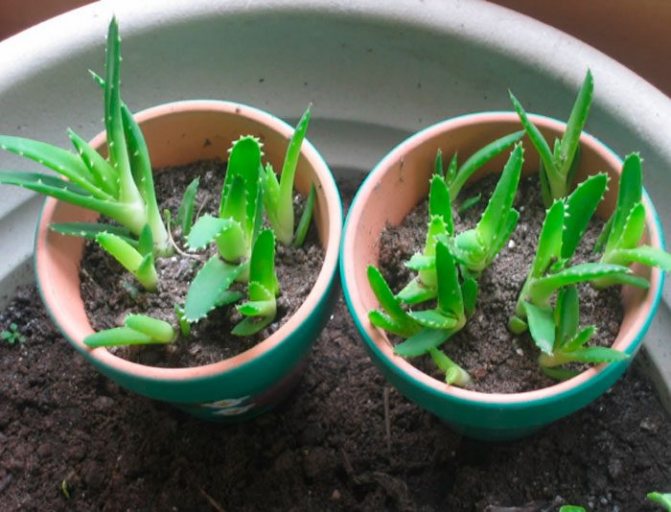

Seed reproduction
Aloe can be grown from seed quite easily. To begin with, a good drainage layer is made at the bottom of the container, then it is filled with a sand mixture and seeds are sown. Sowing is carried out in the last winter or first spring weeks. Crops are provided with regular watering and ventilation. Protect them from direct sunlight, while the air temperature should be around 20 degrees. The picking of the appeared seedlings into individual containers is carried out when they are 30 days old. When 3 months have passed after transplanting, the plant will need to dive again into larger containers, after which they are provided with the same care as adult bushes.
How to propagate by shoots
For propagation of aloe by shoots, use the same soil mixture as for sowing seeds. In the spring or in the first summer weeks, separate the young shoots growing from the roots from the parent bush, after which they are planted in an individual container. After the bush grows roots and starts growing, it is provided with the same care as an adult plant.
Amosov pasta recipe
Amosov's pasta recipe is not surprising - everything is simple: grind the ingredients, mix and store in a sterile container in a cool place. But there is a little secret: the better the ingredients, the healthier the paste. Therefore, you should not chase imported dried fruits - even if raisins, prunes, dried apricots and figs are not as appetizing and beautiful as in the picture, the main thing is that they are from ecologically clean areas (ideally, home production) and stored without breaking the rules. Natural honey is also needed, and if possible, get honey from a beekeeper - it is much more useful than from a store window.
“Every organism contains powerful defenses,” said Nikolai Mikhailovich Amosov, “this is the immune system. It will work, you need to give it some time. Do not forget that most simple illnesses go away on their own, and medical drugs only accompany recovery. "
It is at the activation of the body's natural defenses that the action of Amosov's paste is directed.
Consequences of liquid stagnation and poor ventilation in a flowerpot
As already said, aloe does not tolerate stagnant liquid in a pot... If there is no drainage layer or it is of poor quality, then the water will linger for a long time. In this case, the root system will rot. For aloe, such a phenomenon is disastrous, since the flower grows in the wild in dry lands, even in deserts. It tolerates drought more easily than an excess of fluid.
An equally dangerous moment for aloe is poor ventilation in the flowerpot. When the air cannot penetrate into it unhindered. This is due to the lack of natural disintegrants in the composition of the soil. The consequences of compacted soil are yellowness and drying of the leaves.
Possible problems
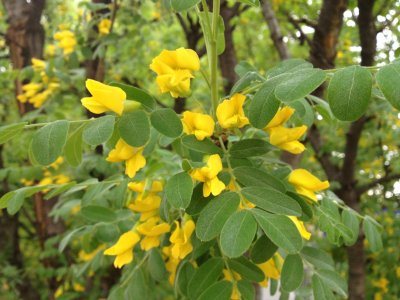

Yellow acacia rarely suffers from disease and infrequently is affected by pests.
Occasionally, in wet years, rust spots may appear on the plant.
You can get rid of the disease or prevent it by spraying the bushes with Bordeaux liquid.
Of the pests, acacia aphids, false scale insects, longhorn beetles and glassworms can attack the caragana. To get rid of these insects, it is necessary to carry out two insecticide treatments. The interval between them is 2-3 weeks.
Any insecticide can be used to control pests, preference should be given to systemic drugs that are quickly absorbed and practically not washed off by rains. Moving along the vascular system of the plant, the preparations reach every part of it, even the one that could not be sprayed.
Botanical classification [edit | edit code]
The genus includes more than 500 species [3], the most famous species are:
- Aloe arborescens Mill. - Aloe tree
Shrub up to 3 m tall. It is used in medicine. Most often, this particular species is called the agave.
- Aloe aristataHaw. - Aloe spinous
- Aloe dichotomaMasson - Aloe dichotomous, or trembling tree, or cockerbum
- Aloe helenaeDanguy - Helena's Aloe
- Aloe nyeriensis Christian & I. Verd. [syn. Aloe ngobitensis Reynolds]
- Aloe plicatilis (L.) Mill. - Aloe folded
Shrub or small tree up to 3-5 m with a short branching trunk.
- Aloe succotrinaLam. - Aloe sokotrinskoe
- Aloe suzannaeDecary - Suzanna's Aloe
- Aloe variegata L. - Tiger aloe, or variegated aloe
- Aloe vera - Aloe present, or Aloe vera, view from the Canary Islands. A plant with a short stem and a rosette of variegated thorny leaves, reaching 60 cm in diameter. It is widely used in medicine and cosmetics. Popular houseplant.
- Aloe wildii (Reynolds) Reynolds
The birthplace of the flower
The homeland of the plant is considered to be South Africa and Madagascar. On the territory of South Africa at the beginning of the first millennium AD. inhabited by tribes who used the flower as a remedy. They carried a few aloe leaves with them to heal their wounds. This is evidenced by archaeological excavations in caves located near Kromdrai and Sterkfontein.
The flower in its homeland prefers semi-desert places, often in the coastal zone, surrounded by other thorny bushes. Occurs in savannas, where sandy or gravelly soil, in mountainous areas up to 2700 m above sea level.
Step-by-step cooking recipe
It is difficult to get confused in the amount of ingredients - all the components of Amosov's mixture are taken equally (with the exception, perhaps, of lemon):
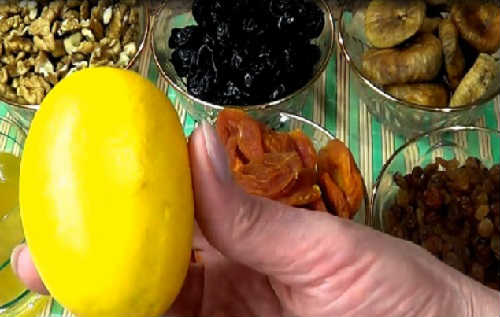

- dried apricots - 350 g;
- dried figs - 350g;
- raisins (white or dark) - 350 g;
- prunes - 350 g;
- walnut kernel - 350g;
- natural honey - 350 g;
- medium lemon - 1 pc.
- First of all, we cleanse the litter and rinse all the ingredients thoroughly. Dried fruits can be soaked in water.
- My lemon is especially careful - as a rule, the peel is treated with not very useful substances for long-term storage. You can additionally scald the citrus with boiling water. Cut the lemon into slices. Remove all bones.
- We wash the dried fruits pre-soaked overnight, drain the water and let them dry a little.
- We pass all the ingredients (except for honey and nuts) through a medium-sized grinder grid.
- Grind the nut with a knife or mortar.
- Mix the crushed ingredients in a bowl, add honey and knead well - the paste requires a uniform consistency.
- Then we pack the sweet and viscous pasta into jars and store with the lids closed in the refrigerator. Sometimes lemon is replaced with lime - the taste and benefits do not suffer from this!
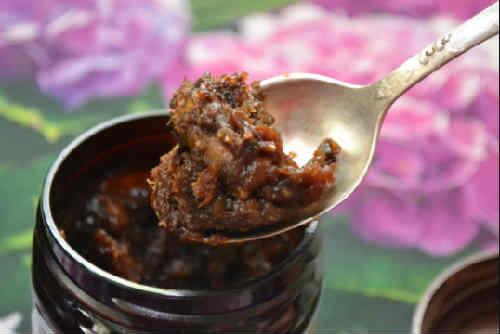

Top dressing
So that nutrients are beneficial to the plant, and not harmful, it is important to adhere to certain rules when fertilizing aloe:
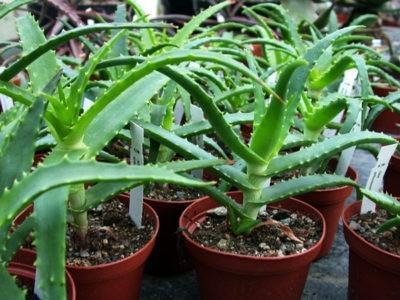

A recently transplanted flower in a new land does not need feeding. The soil contains enough useful micro and macro elements necessary for development. Only six months later, you should think about fertilizers.- Before applying top dressing to the soil, it is necessary to moisten it. You can pour a weakly concentrated solution into the pan. Or pour on top, but only along the edge of the pot, so as not to burn the leaves and stem of the flower.
- Fertilizing aloe is in warm weather, from May to September. Enough once every two weeks and the flower will actively grow.
Experienced growers recommend using fertilizers of the Bona Forte and Power of Life brands. They strengthen the root system well, activate metabolic processes, stimulate growth, and increase the plant's resistance to diseases.
Content
- 1 Title
- 2 Biological description
- 3 Distribution
- 4 Systematic position
- 5 Botanical classification
- 6 Content of substances
- 7 Economic value and use 7.1 Medical use 7.1.1 Gastroenterology
- 7.1.2 Ophthalmology
- 7.1.3 Traditional medicine
Amosov paste for the heart
"Cores" are the main target audience for which the Amosov paste was developed. The recipe, reviews of which for decades have only been positive, is simple and affordable. But is it really that effective?
We have already found out that Amosov's pasta is rich in potassium, magnesium and sodium. These trace elements are interconnected and perform the following functions in the body:
create conditions for the normal functioning of muscle contractions; maintain the osmotic concentration of blood; help maintain acid-base balance; normalize water-salt balance; potassium protects the heart from overload and plays an important role in the conduction of electrical impulses to the heart muscle and its contraction.
Regular intake of magnesium helps to maintain vascular and muscle tone, evens out the heart rate and allows you to resist stress. The average daily intake for an adult is 400 mg of magnesium.
A lack of potassium provokes the development of hypokalemia, which causes disturbances in the work of the heart muscles. With prolonged micronutrient deficiency, neuralgia often develops.
The recommended dose of potassium per day is:
children - from 600 to 1700 mg; adults - from 1800 to 5000 mg.
But an overabundance of potassium is dangerous - it is fraught with hyperkalemia, in which an intestinal ulcer develops, in addition, it can cause cardiac arrest.
Thus, it is not worth getting carried away with the use of a product that is safe at first glance. Everything is good in moderation - do not forget about this axiom, and let your heart work like a good Swiss watch - without interruption!
Who needs Amosov's pasta
What is this miracle - pasta? And who was its creator?
A few words about the brilliant academician
Academician Nikolai Mikhailovich Amosov (1913-2002) is an amazing person, whatever you say. He did so much for domestic science and medicine (in particular, cardiology) that without his brilliant discoveries, so many lives would hardly have been saved today. And just think, like most Russian geniuses, Nikolai Mikhailovich was born in an ordinary family, not only poor, but even poor. His homeland is the Novgorod region, the town of Olkhovo near Cherepovets. He was associated with medicine, in the literal sense of the word, even before his birth - his mother was a midwife. And at first Amosov did not think about medicine - he graduated from a technical school as a mechanic. And only after getting married, with a difference of a year, he entered the engineering institute and the medical institute, which he graduated with honors. He was fascinated by physiology, but they also say the truth, everything that is done is for the best. In the medical institute in graduate school there were only places in the department of surgery. Amosov became a surgeon. During the war, he saved more than 4,000 lives - all in a tiny field hospital.


For the first time in the history of the USSR, Amosov performed the first operation to implant artificial heart valves. His developments and research can be called fundamental in the field of cardiovascular surgery. It should be noted that Amosov himself underwent more than one heart operation and died of a heart attack at the age of 90. And all these years he looked vigorous and fit, kept an excellent shape.
It was Nikolai Amosov, a supporter of a healthy diet and lifestyle, who developed a special nutritional supplement, which he recommended to include in the diet for all his post-operable patients.
General information about the mixture
What is Academician Amosov's pasta? Its recipe is based on a general strengthening effect on the body as a whole and in particular on the cardiovascular system. The components of the paste are crushed dried fruits, citruses and nuts, ground with honey. Regular consumption of the paste helps to restore the body and activate the body's defenses.
Progress of organized educational activities
Educator: Guys, we have a picture on the blackboard with the image of one very interesting plant. I will give you a riddle, and you try to guess what it is?
"Will decorate the house for a whole century,
And he will heal everyone in that house.
That flower is unsightly in appearance,
But he is famous as a healer "
Who guessed what kind of plant it was? (children's answers)
it
aloe, he also has a second name - "agave"
... It is connected with the belief that
aloe blooms only once in a hundred years, and then dies ... But this is not so. It's just that in our homes it is very difficult to create the same conditions as in his homeland in Africa. And there aloe blooms every year! Who has seen this plant? What does it look like? (children's answers)
Now let's look at the picture
(opens)
.
The appearance of this plant is not very attractive, it looks like a creature with many tentacles covered with thorns. But it turns out that the flowers aloe is very beautiful! Would you like to see?
For children a short educational video is shown “When it blooms aloe»
.
Despite its unsightly and even unpleasant appearance, aloe a very valuable plant? Why? (children's answers)
... That's right, this is a real healer.
Aloe contains the healing substance aloin, which heals wounds and fights germs.
Our doll Masha does not heal the wound on her arm. Let's put a healing bandage on her. To do this, we cut off the leaf, remove the skin from it and attach it to the wound. Who will help me? (The teacher cuts off the skin aloe, baby imposes "Bandage"
and fixes it on the doll's arm with an adhesive plaster). After a while, the bandage can be changed.
Popular talks
The most amazing animal on our planet - the chameleon (lat.chamaeleonidae) - belongs to the class of reptiles, the squamous order. This lizard is known for its ability to change its color and blend in with the surrounding nature.
Diplodocus is a dinosaur that lived during the Jurassic period, about 140 million years ago. Diplodocus belongs to the order of lizards - sauropod. This type of dinosaur is known as one of the largest, its size could reach 35 m in length and 10-15 m in height.
Probably everyone knows that basketball is the most famous and popular sport. Basketball is a sports game in which a certain number of people are recruited. And each of the teams tries to score the ball in different ways
Among domestic plants, there is one that has many useful properties, its name is familiar to everyone - this is Aloe. The flower looks like a cross between a cactus and a palm tree and belongs to the genus of succulents. In nature, aloe is used to growing in arid regions, therefore it does not require frequent watering and accumulates water in its fleshy pointed leaves.
Spread
Plants of the genus Aloe originate from the arid regions of South and tropical Africa, Madagascar and the Arabian Peninsula [8].
Aloe mostly grows in warm, dry climates, and it's no surprise that many people mistake it for a cactus.
Aloe can survive when other plants wither and die. This allowed Aloe to survive the harsh changes in the climate of our planet and survive to our times. In extreme situations, this plant closes the pores of the peel, trapping moisture inside the leaf. In the leaves of aloe, a fairly large supply of moisture is created.
Reproduction methods
Reproduction of yellow acacia is possible in various ways: by seeds, cuttings, shoots, dividing bushes, grafting.
Yellow acacia seeds sprout well. The sprouts appear in about a month. Seed stratification is not required. Good germination of seeds sometimes leads to the formation of a large amount of self-seeding, which can also be used for reproduction.
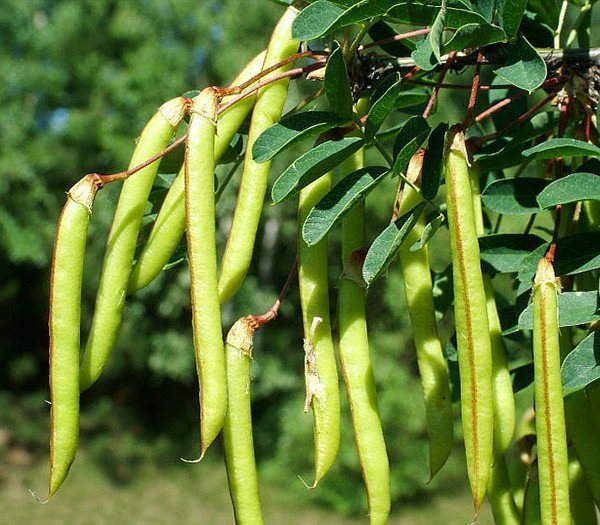

Cuttings for rooting are used both green and lignified. Reproduction of the latter is better. To speed up root formation in green cuttings, stimulants are used.
Dividing the bush and digging out root suckers is the easiest and fastest way to propagate tree caragana. The most convenient way to do this is in the spring or mid-autumn.
Grafting is usually used to obtain standard forms of a narrow-leaved and drooping variety of tree caragana. Budding gives good rootstock survival. An incision is made at a height of 1-1.5 m from the surface of the earth. After the shield with the kidney is placed in the incision, the bark is pressed and a strap is applied. It will have to be removed next spring.
Suitable soil to plant outdoors
With the arrival of spring, it is recommended to take the aloe pot outside. or planted in open ground. If you decide to plant a flower, then it is important to know some of the nuances when choosing a place:
- a lot of sun;
- you should not choose lowlands where moisture stagnation is possible;
- preferably sandy soils.
In principle, the composition of the soil for aloe needs the same as in a pot. It is better to transplant directly with a lump of soil in which it grew. If there is not enough sand in the ground, you can add it, and then dig up the area for planting a flower. The bottom of the hole should be laid out with expanded clay or other drainage. Watering is needed rare (how to properly water aloe?).

